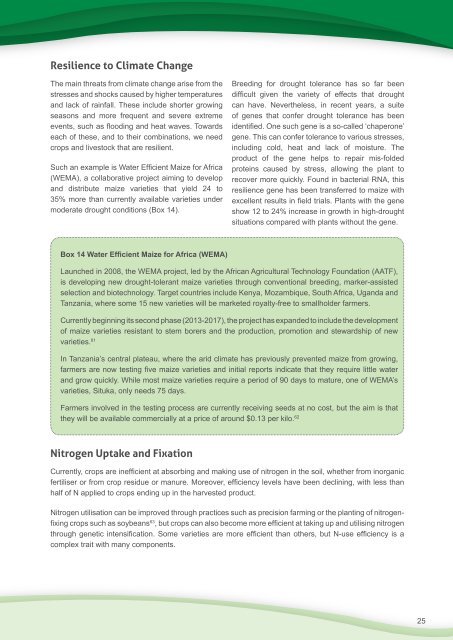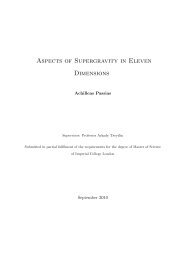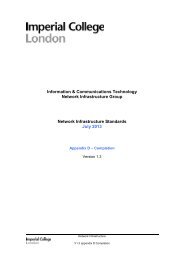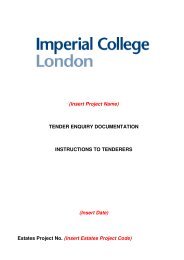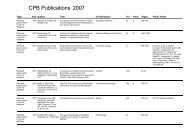Sustainable Intensification: - Workspace - Imperial College London
Sustainable Intensification: - Workspace - Imperial College London
Sustainable Intensification: - Workspace - Imperial College London
Create successful ePaper yourself
Turn your PDF publications into a flip-book with our unique Google optimized e-Paper software.
Resilience to Climate Change<br />
The main threats from climate change arise from the<br />
stresses and shocks caused by higher temperatures<br />
and lack of rainfall. These include shorter growing<br />
seasons and more frequent and severe extreme<br />
events, such as flooding and heat waves. Towards<br />
each of these, and to their combinations, we need<br />
crops and livestock that are resilient.<br />
Such an example is Water Efficient Maize for Africa<br />
(WEMA), a collaborative project aiming to develop<br />
and distribute maize varieties that yield 24 to<br />
35% more than currently available varieties under<br />
moderate drought conditions (Box 14).<br />
Box 14 Water Efficient Maize for Africa (WEMA)<br />
Nitrogen Uptake and Fixation<br />
Breeding for drought tolerance has so far been<br />
difficult given the variety of effects that drought<br />
can have. Nevertheless, in recent years, a suite<br />
of genes that confer drought tolerance has been<br />
identified. One such gene is a so-called ‘chaperone’<br />
gene. This can confer tolerance to various stresses,<br />
including cold, heat and lack of moisture. The<br />
product of the gene helps to repair mis-folded<br />
proteins caused by stress, allowing the plant to<br />
recover more quickly. Found in bacterial RNA, this<br />
resilience gene has been transferred to maize with<br />
excellent results in field trials. Plants with the gene<br />
show 12 to 24% increase in growth in high-drought<br />
situations compared with plants without the gene.<br />
Launched in 2008, the WEMA project, led by the African Agricultural Technology Foundation (AATF),<br />
is developing new drought-tolerant maize varieties through conventional breeding, marker-assisted<br />
selection and biotechnology. Target countries include Kenya, Mozambique, South Africa, Uganda and<br />
Tanzania, where some 15 new varieties will be marketed royalty-free to smallholder farmers.<br />
Currently beginning its second phase (2013-2017), the project has expanded to include the development<br />
of maize varieties resistant to stem borers and the production, promotion and stewardship of new<br />
varieties. 61<br />
In Tanzania’s central plateau, where the arid climate has previously prevented maize from growing,<br />
farmers are now testing five maize varieties and initial reports indicate that they require little water<br />
and grow quickly. While most maize varieties require a period of 90 days to mature, one of WEMA’s<br />
varieties, Situka, only needs 75 days.<br />
Farmers involved in the testing process are currently receiving seeds at no cost, but the aim is that<br />
they will be available commercially at a price of around $0.13 per kilo. 62<br />
Currently, crops are inefficient at absorbing and making use of nitrogen in the soil, whether from inorganic<br />
fertiliser or from crop residue or manure. Moreover, efficiency levels have been declining, with less than<br />
half of N applied to crops ending up in the harvested product.<br />
Nitrogen utilisation can be improved through practices such as precision farming or the planting of nitrogenfixing<br />
crops such as soybeans 63 , but crops can also become more efficient at taking up and utilising nitrogen<br />
through genetic intensification. Some varieties are more efficient than others, but N-use efficiency is a<br />
complex trait with many components.<br />
25


